原创 杨柠菲 华西医院耳鼻喉科
阅读最新文献,紧跟前沿进展,这是一名研究者必须具备的习惯和要求。我们华西医院耳鼻咽喉头颈外科的硕士、博士研究生和博士后们自2019年以来,每周开展一次文献泛读和文献精读分享会,至今已累计开展了200多次。2023年9月13日开始,本科室陆续将其进行整理,同步推出在线前沿速递和文献解读板块。通过这种学习和分享的方式,使汇报者和大家都能对近期权威期刊发表的高质量研究有所了解,同时也是学习其他优秀研究者思路、方法和理论的良好手段。希望通过这种形式,把科内的分享扩大到所有的读者,一起学习,共同进步!
华西医院耳鼻咽喉头颈外科

【Cell导读】2025年1-2月刊论文导读
期刊介绍:
Cell是Cell Press细胞出版社旗下的旗舰刊,创办于1974年,由Elsevier公司出版发行。这是一本多学科期刊,包括但不限于细胞生物学、分子生物学、神经科学、免疫学、病毒学和微生物学、癌症、人类遗传学、系统生物学、信号传导和疾病机制和疾病治疗。该期刊为双周刊,最新影响因子为45.5。
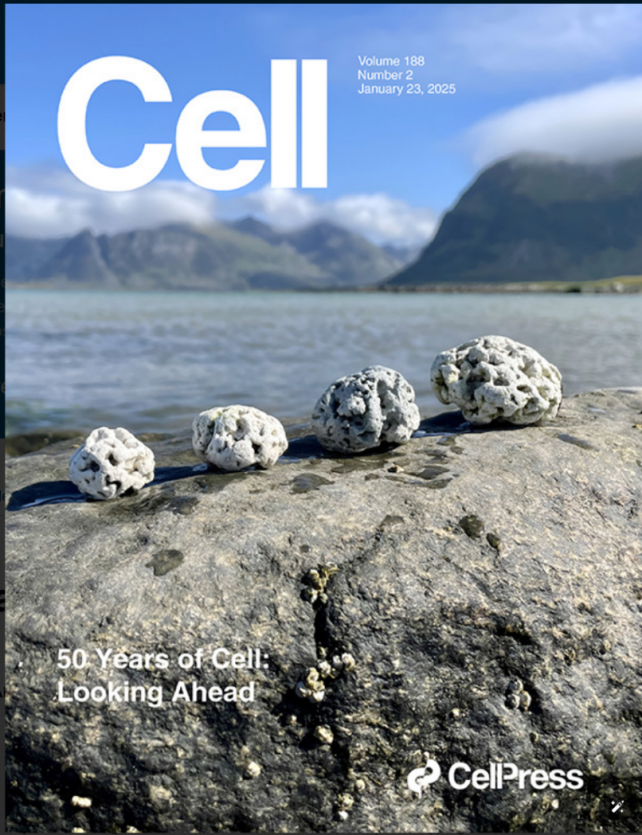
Jan 23, 2025 Volume 188 Issue 2p273-572
2025年1月23日此期共发表Previews 2篇,Short Articles 1篇,Articles 15篇,Resources 1篇。
1.How NINJ1 mediates plasma membrane rupture and why NINJ2 cannot
NINJ1如何介导质膜破裂以及为什么 NINJ2 不能
Ninjurin-1 (NINJ1) is an active executioner of plasma membrane rupture (PMR), a process previously thought to be a passive osmotic lysis event in lytic cell death. Ninjurin-2 (NINJ2) is a close paralog of NINJ1 but cannot mediate PMR. Using cryogenic electron microscopy (cryo-EM), we show that NINJ1 and NINJ2 both assemble into linear filaments that are hydrophobic on one side but hydrophilic on the other. This structural feature and other evidence point to a PMR mechanism by which NINJ1 filaments wrap around and solubilize membrane fragments and, less frequently, form pores in the plasma membrane. In contrast to the straight NINJ1 filament, the NINJ2 filament is curved toward the intracellular space, preventing its circularization or even assembly on a relatively flat membrane to mediate PMR. Mutagenesis studies further demonstrate that the NINJ2 filament curvature is induced by strong association with lipids, particularly a cholesterol molecule, at the cytoplasmic leaflet of the lipid bilayer.
神经损伤诱导蛋白-1(NINJ1)是质膜破裂(PMR)的主动执行者,这一过程过去曾被认为是裂解性细胞死亡中被动渗透的溶解事件。神经损伤诱导蛋白-2(NINJ2)是NINJ1的密切旁系同源物,但无法介导PMR。通过冷冻电镜(cryo-EM)技术,研究者发现NINJ1和NINJ2均可组装成线性丝状结构,这些结构具有单侧疏水而另一侧亲水的特性。这一结构特征及其他证据表明,NINJ1通过其丝状结构包裹并溶解膜碎片,并在少数情况下于质膜上形成孔洞来实现PMR机制。与直线状的NINJ1丝状结构不同,NINJ2丝状体向细胞内空间弯曲,这种构象阻碍了其在相对平坦的膜结构上完成环化组装或有效组装以介导PMR。进一步的诱变研究表明,NINJ2丝状结构的弯曲是由其与脂质(特别是脂双层胞质小叶中的胆固醇分子)的强结合作用所诱导的。
2.Engineering and structures of Crimean-Congo hemorrhagic fever virus glycoprotein complexes
克里米亚-刚果出血热病毒糖蛋白复合物的工程化和结构
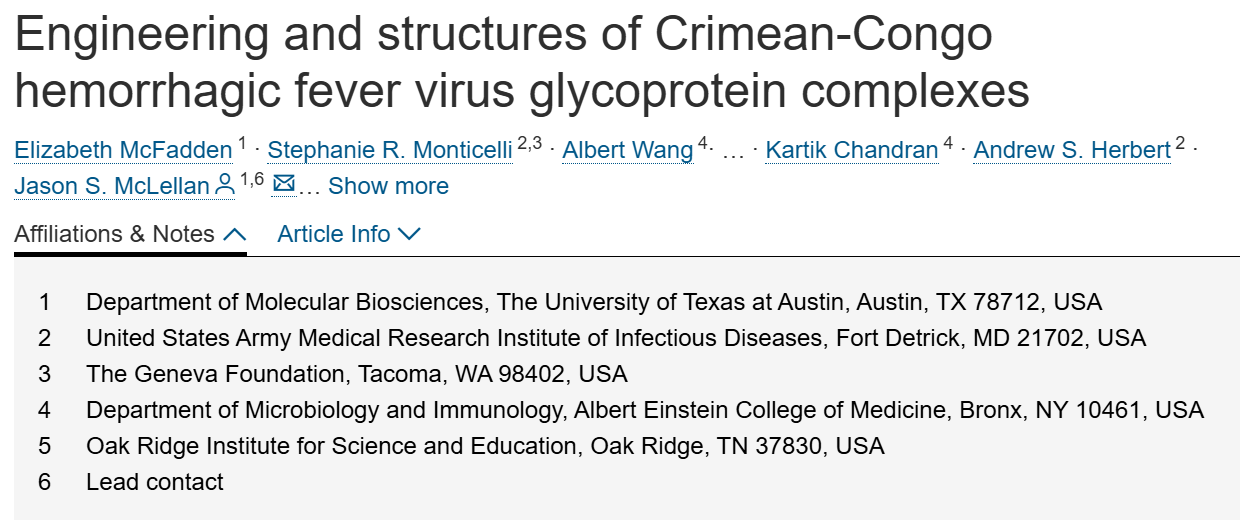
Crimean-Congo hemorrhagic fever virus (CCHFV) is a tickborne virus that can cause severe disease in humans with case fatality rates of 10%–40%. Although structures of CCHFV glycoproteins GP38 and Gc have provided insights into viral entry and defined epitopes of neutralizing and protective antibodies, the structure of glycoprotein Gn and its interactions with GP38 and Gc have remained elusive. Here, we use structure-guided protein engineering to produce a stabilized GP38-Gn-Gc heterotrimeric glycoprotein complex (GP38-GnH-DS-Gc). A cryo-electron microscopy (cryo-EM) structure of this complex provides the molecular basis for GP38’s association on the viral surface, reveals the structure of Gn, and demonstrates that GP38-Gn restrains the Gc fusion loops in the prefusion conformation, facilitated by an N-linked glycan attached to Gn. Immunization with GP38-GnH-DS-Gc conferred 40% protection against lethal IbAr10200 challenge in mice. These data define the architecture of a GP38-Gn-Gc protomer and provide a template for structure-guided vaccine antigen development.
克里米亚-刚果出血热病毒(CCHFV)是一种蜱传病毒,可引发人类严重疾病,病死率达10%-40%。尽管克里米亚-刚果出血热病毒(CCHFV)的糖蛋白GP38和Gc的结构已为病毒入侵机制提供了重要见解,并明确了中和抗体及保护性抗体的表位特征,但糖蛋白Gn的结构及其与GP38和Gc的相互作用机制仍不明确。本研究通过结构导向的蛋白质工程技术,成功构建了稳定的GP38-Gn-Gc异源三聚体糖蛋白复合物(GP38-GnH-DS-Gc)。该复合物的冷冻电镜结构揭示了GP38在病毒表面的结合机制,解析了Gn的分子结构,并证明了GP38-Gn通过Gn上的N-连接聚糖将Gc融合环稳定在预融合构象。实验表明,使用GP38-GnH-DS-Gc进行免疫接种可使小鼠对致死剂量IbAr10200毒株的攻击获得40%的保护率。该研究不仅阐明了GP38-Gn-Gc原聚体的结构框架,也为基于结构的疫苗抗原开发提供了重要模板。
3.A gut commensal protozoan determines respiratory disease outcomes by shaping pulmonary immunity
肠道共生原生动物通过塑造肺免疫决定呼吸道疾病结局
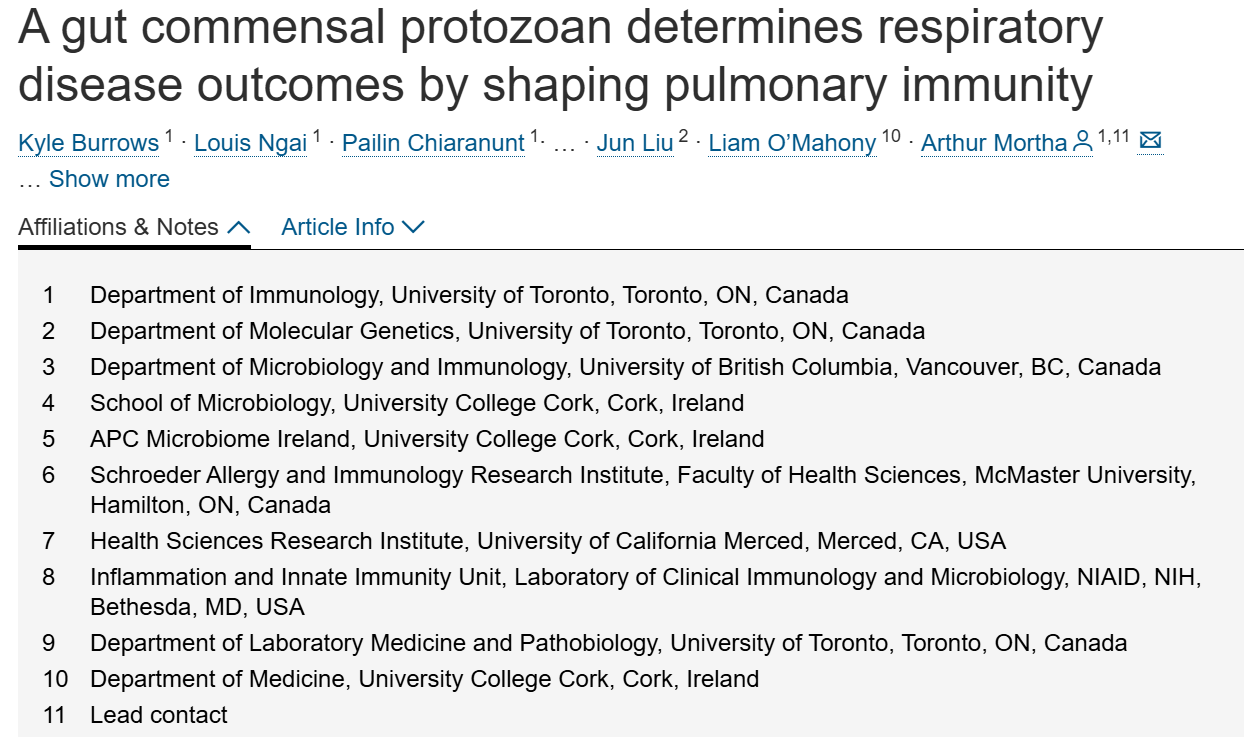
The underlying mechanisms used by the intestinal microbiota to shape disease outcomes of the host are poorly understood. Here, we show that the gut commensal protozoan, Tritrichomonas musculis (T.mu), remotely shapes the lung immune landscape to facilitate perivascular shielding of the airways by eosinophils. Lung-specific eosinophilia requires a tripartite immune network between gut-derived inflammatory group 2 innate lymphoid cells and lung-resident T cells and B cells. This network exacerbates the severity of allergic airway inflammation while hindering the systemic dissemination of pulmonary Mycobacterium tuberculosis. The identification of protozoan DNA sequences in the sputum of patients with severe allergic asthma further emphasizes the relevance of commensal protozoa in human disease. Collectively, these findings demonstrate that a commensal protozoan tunes pulmonary immunity via a gut-operated lung immune network, promoting both beneficial and detrimental disease outcomes in response to environmental airway allergens and pulmonary infections.
肠道微生物群影响宿主疾病结局的潜在机制尚不明确。本研究揭示肠道共生原生生物——鼠三毛滴虫(Tritrichomonas musculis,T.mu)通过远程调控肺部免疫微环境,促进嗜酸性粒细胞对气道周围血管的保护。这种肺特异性嗜酸性粒细胞增多现象依赖于由肠道来源的炎症性2型先天淋巴样细胞、肺组织驻留T细胞和B细胞构成的三元免疫网络。该网络在加剧过敏性气道炎症严重程度的同时,却阻碍了肺部结核分枝杆菌的全身播散。值得注意的是,在严重过敏性哮喘患者痰液中检测到原生生物DNA序列,进一步印证了共生原生生物在人类疾病中的相关性。综合研究结果表明,共生原生生物通过肠道-肺免疫调控网络重塑肺部免疫应答,这种双向调节作用在应对环境性气道过敏原和肺部感染时,既可产生保护性效应,也可能导致病理性损伤。
YTHDF2 promotes ATP synthesis and immune evasion in B cell malignancies
YTHDF2 在 B 细胞恶性肿瘤中促进 ATP 合成和免疫逃避
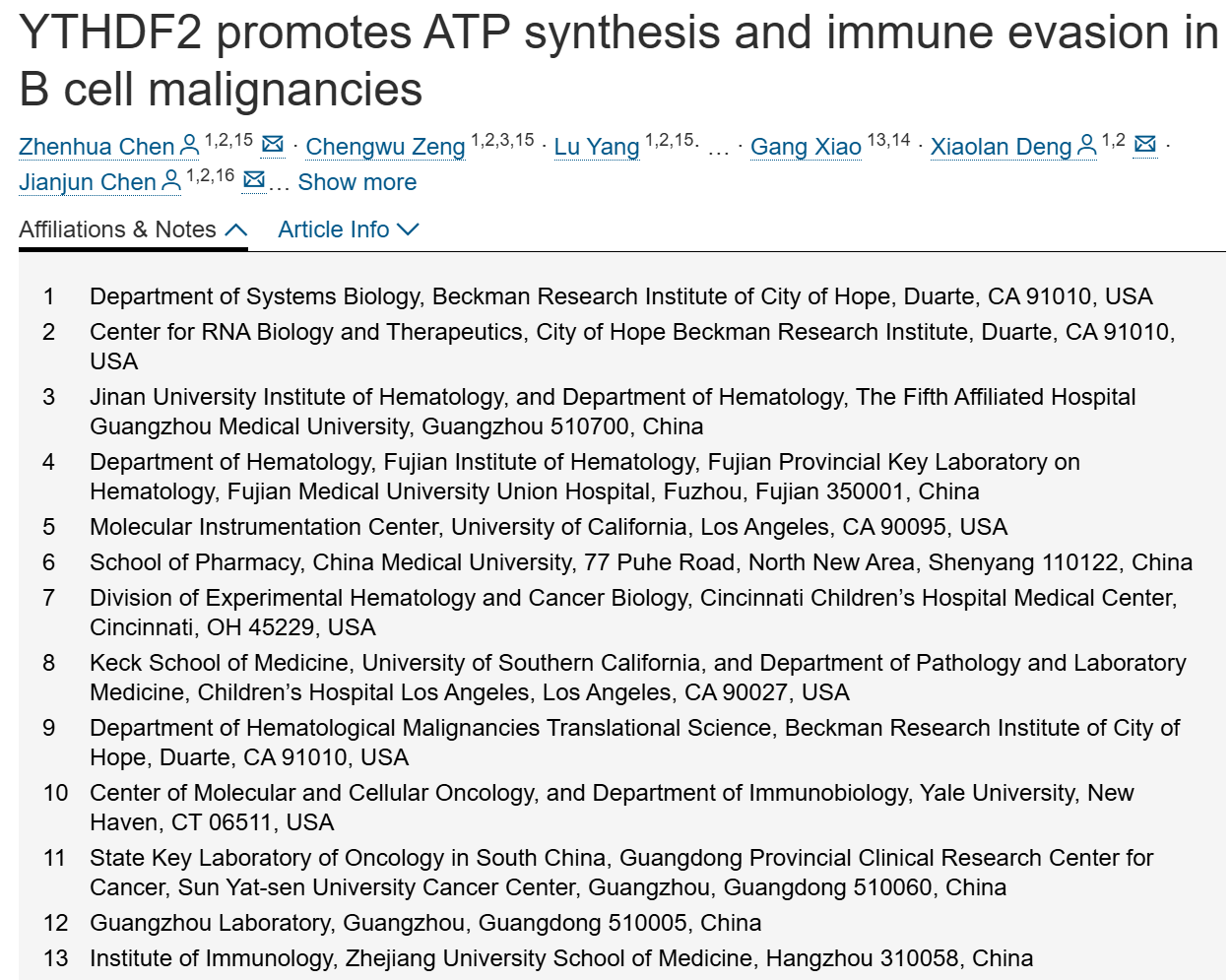
Long-term durable remission in patients with B cell malignancies following chimeric antigen receptor (CAR)-T cell immunotherapy remains unsatisfactory, often due to antigen escape. Malignant B cell transformation and oncogenic growth relies on efficient ATP synthesis, although the underlying mechanisms remain unclear. Here, we report that YTHDF2 facilitates energy supply and antigen escape in B cell malignancies, and its overexpression alone is sufficient to cause B cell transformation and tumorigenesis. Mechanistically, YTHDF2 functions as a dual reader where it stabilizes mRNAs as a 5-methylcytosine (m5C) reader via recruiting PABPC1, thereby enhancing their expression and ATP synthesis. Concomitantly, YTHDF2 also promotes immune evasion by destabilizing other mRNAs as an N6-methyladenosine (m6A) reader. Small-molecule-mediated targeting of YTHDF2 suppresses aggressive B cell malignancies and sensitizes them to CAR-T cell therapy.
尽管嵌合抗原受体(CAR)-T细胞免疫疗法在B细胞恶性肿瘤治疗中取得进展,但患者长期持续缓解效果仍不理想,这通常与抗原逃逸现象相关。恶性B细胞转化及致癌性生长依赖于高效的ATP合成,但其分子机制尚未阐明。本研究发现YTHDF2通过双重机制促进B细胞恶性肿瘤的能量供应与免疫逃逸,其单独过表达即可驱动B细胞恶性转化及肿瘤发生。机制研究表明:YTHDF2作为双功能RNA修饰阅读器,一方面通过识别5-甲基胞嘧啶(m5C)修饰并招募PABPC1来稳定特定mRNA,从而增强其表达并促进ATP合成;另一方面作为N6-甲基腺苷(m6A)阅读器通过降解其他mRNA促进免疫逃逸。小分子靶向抑制YTHDF2可有效抑制侵袭性B细胞恶性肿瘤,并增强其对CAR-T细胞治疗的敏感性。
Ongoing chromothripsis underpins osteosarcoma genome complexity and clonal evolution
持续发生的染色体碎裂是骨肉瘤基因复杂性和克隆进化的基础
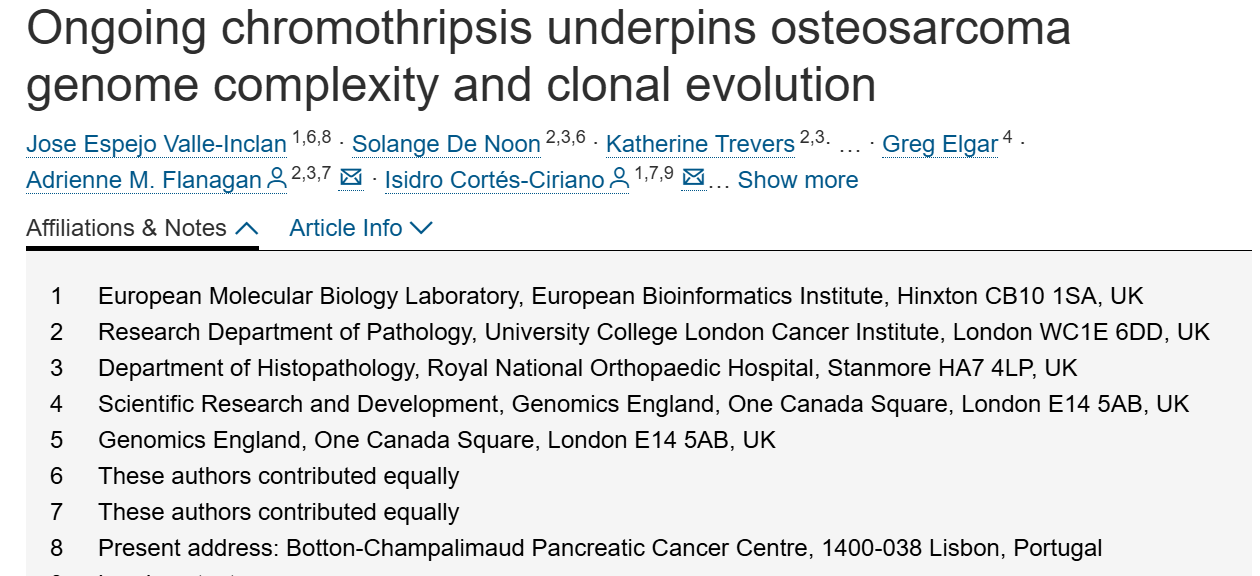
Osteosarcoma is the most common primary cancer of the bone, with a peak incidence in children and young adults. Using multi-region whole-genome sequencing, we find that chromothripsis is an ongoing mutational process, occurring subclonally in 74% of osteosarcomas. Chromothripsis generates highly unstable derivative chromosomes, the ongoing evolution of which drives the acquisition of oncogenic mutations, clonal diversification, and intra-tumor heterogeneity across diverse sarcomas and carcinomas. In addition, we characterize a new mechanism, termed loss-translocation-amplification (LTA) chromothripsis, which mediates punctuated evolution in about half of pediatric and adult high-grade osteosarcomas. LTA chromothripsis occurs when a single double-strand break triggers concomitant TP53 inactivation and oncogene amplification through breakage-fusion-bridge cycles. It is particularly prevalent in osteosarcoma and is not detected in other cancers driven by TP53 mutation. Finally, we identify the level of genome-wide loss of heterozygosity as a strong prognostic indicator for high-grade osteosarcoma.
骨肉瘤是最常见的原发性骨癌,其发病率在儿童和青少年中达到高峰。通过多区域全基因组测序,研究者发现染色体碎裂是一个持续进行的突变过程,在74%的骨肉瘤中以亚克隆形式存在。染色体碎裂会产生高度不稳定的衍生染色体,其持续进化驱动了致癌突变、克隆多样化以及多种肉瘤和癌中的肿瘤内异质性。此外,研究者描述了一种新机制——缺失-易位-扩增(LTA)型染色体碎裂,该机制介导了约半数儿童和成人高级别骨肉瘤的间断式进化。当单个双链断裂通过断裂-融合-桥接循环同时引发TP53失活和癌基因扩增时,就会发生LTA型染色体碎裂。这种现象在骨肉瘤中尤为普遍,而在其他由TP53突变驱动的癌症中未被检测到。最后,研究者确定全基因组杂合性缺失水平可作为高级别骨肉瘤的重要预后指标。
A commonly inherited human PCSK9 germline variant drives breast cancer metastasis via LRP1 receptor
一种普遍的人类 PCSK9 遗传基因变异通过 LRP1 受体驱动乳腺癌转移
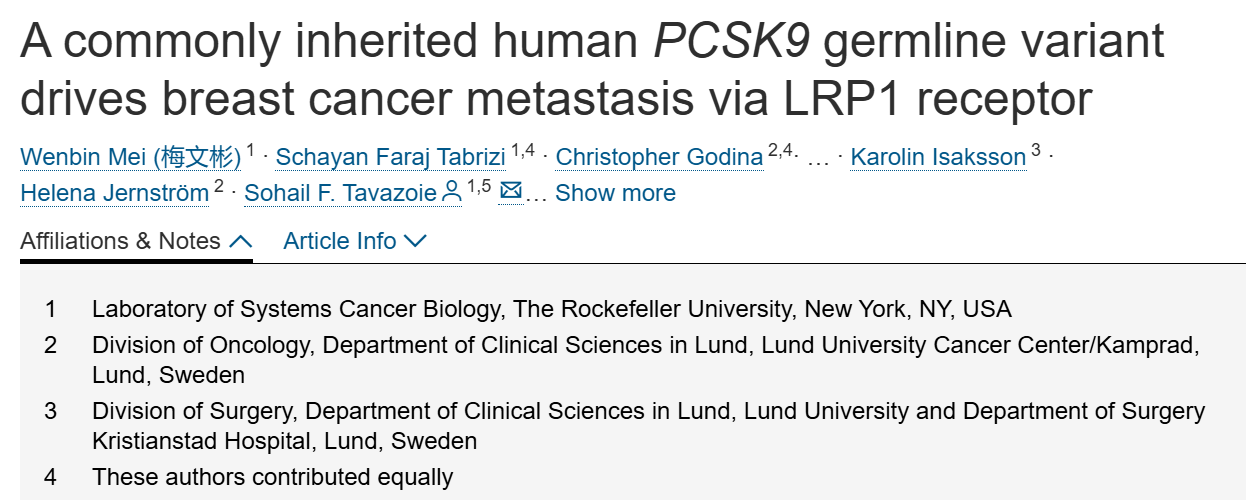
Identifying patients at risk for metastatic relapse is a critical medical need. We identified a common missense germline variant in proprotein convertase subtilisin/kexin type 9 (PCSK9) (rs562556, V474I) that is associated with reduced survival in multiple breast cancer patient cohorts. Genetic modeling of this gain-of-function single-nucleotide variant in mice revealed that it causally promotes breast cancer metastasis. Conversely, host PCSK9 deletion reduced metastatic colonization in multiple breast cancer models. Host PCSK9 promoted metastatic initiation events in lung and enhanced metastatic proliferative competence by targeting tumoral low-density lipoprotein receptor related protein 1 (LRP1) receptors, which repressed metastasis-promoting genes XAF1 and USP18. Antibody-mediated therapeutic inhibition of PCSK9 suppressed breast cancer metastasis in multiple models. In a large Swedish early-stage breast cancer cohort, rs562556 homozygotes had a 22% risk of distant metastatic relapse at 15 years, whereas non-homozygotes had a 2% risk. Our findings reveal that a commonly inherited genetic alteration governs breast cancer metastasis and predicts survival—uncovering a hereditary basis underlying breast cancer metastasis.
识别存在转移性复发风险的患者是一项关键的医疗需求。研究者发现前蛋白转化酶枯草溶菌素9(PCSK9)中的一个常见错义胚系变异(rs562556,V474I)与多个乳腺癌患者队列中生存率降低相关。在小鼠模型中对该功能获得性单核苷酸变异进行遗传建模显示,该变异会因果性地促进乳腺癌转移。相反,宿主PCSK9基因缺失可减少多种乳腺癌模型中的转移定植。宿主PCSK9通过靶向肿瘤低密度脂蛋白受体相关蛋白1(LRP1)受体,促进肺部的转移启动事件并增强转移增殖能力,从而抑制促转移基因XAF1和USP18。抗体介导的PCSK9治疗性抑制在多种模型中均能抑制乳腺癌转移。在瑞典一个大型早期乳腺癌队列中,rs562556纯合子患者在15年内发生远处转移复发的风险为22%,而非纯合子患者的风险仅为2%。本研究揭示,一种常见的遗传性基因变异调控乳腺癌转移并能预测生存率——这揭示了乳腺癌转移的遗传基础。
Characterizing and targeting glioblastoma neuron-tumor networks with retrograde tracing
利用逆向追踪技术表征和靶向胶质母细胞瘤的神经元-肿瘤网络
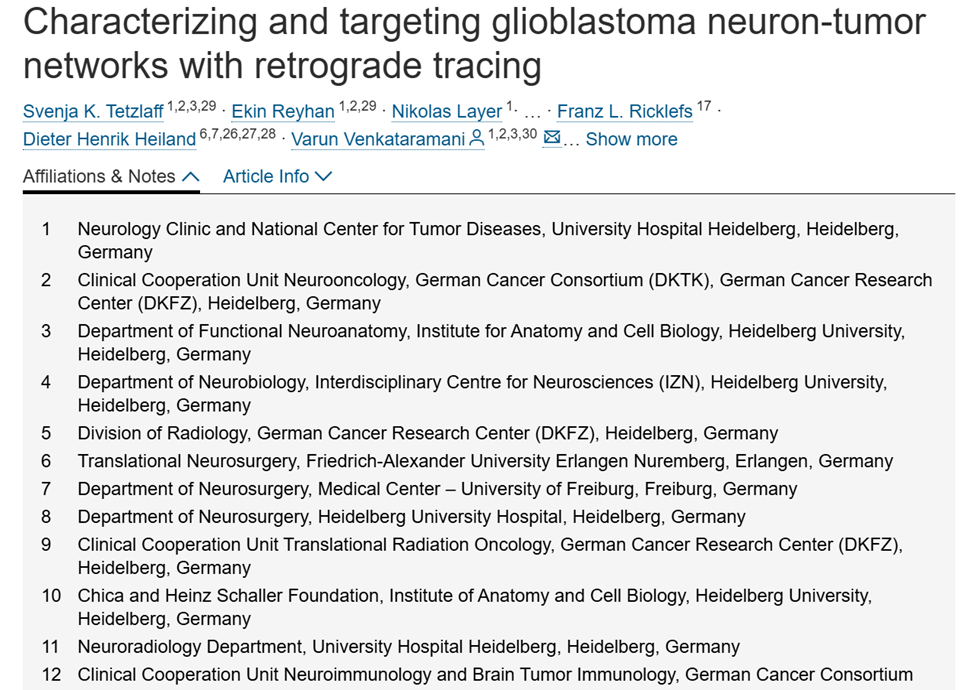
Glioblastomas are invasive brain tumors with high therapeutic resistance. Neuron-to-glioma synapses have been shown to promote glioblastoma progression. However, a characterization of tumor-connected neurons has been hampered by a lack of technologies. Here, we adapted retrograde tracing using rabies viruses to investigate and manipulate neuron-tumor networks. Glioblastoma rapidly integrated into neural circuits across the brain, engaging in widespread functional communication, with cholinergic neurons driving glioblastoma invasion. We uncovered patient-specific and tumor-cell-state-dependent differences in synaptogenic gene expression associated with neuron-tumor connectivity and subsequent invasiveness. Importantly, radiotherapy enhanced neuron-tumor connectivity by increased neuronal activity. In turn, simultaneous neuronal activity inhibition and radiotherapy showed increased therapeutic effects, indicative of a role for neuron-to-glioma synapses in contributing to therapeutic resistance. Lastly, rabies-mediated genetic ablation of tumor-connected neurons halted glioblastoma progression, offering a viral strategy to tackle glioblastoma. Together, this study provides a framework to comprehensively characterize neuron-tumor networks and target glioblastoma.
胶质母细胞瘤是具有高治疗抵抗性的侵袭性脑肿瘤。神经元-胶质瘤突触已被证实会促进胶质母细胞瘤进展。然而,由于技术手段的缺乏,针对与肿瘤连接的神经元特征的研究一直受阻。本研究采用狂犬病病毒逆行追踪技术对神经元-肿瘤网络进行探究与调控。研究发现,胶质母细胞瘤能快速整合至全脑神经回路,参与广泛的神经元功能性通讯,其中胆碱能神经元驱动肿瘤侵袭。研究者发现与神经元-肿瘤连接相关的突触形成基因的表达存在患者特异性及肿瘤细胞状态依赖性差异,这些差异与后续的侵袭性相关。值得注意的是,放射治疗通过增强神经元活性促进了神经元-肿瘤连接。相应地,同步实施神经元活性抑制与放射治疗显示出协同增效作用,表明神经元-胶质瘤突触在治疗抵抗中发挥重要作用。最后,通过狂犬病毒介导的基因消融技术清除这些与肿瘤连接的神经元可阻止胶质母细胞瘤进展,为治疗胶质母细胞瘤提供了一种病毒策略。本研究共同构建了一个全面解析神经元-肿瘤网络并靶向治疗胶质母细胞瘤的研究框架。
ACSL4 and polyunsaturated lipids support metastatic extravasation and colonization
ACSL4 和多不饱和脂质支持转移性外渗和定植
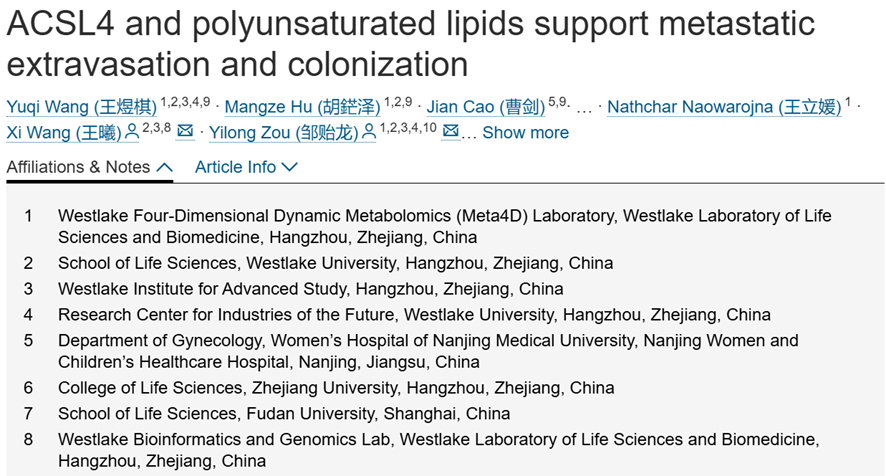
Metastatic dissemination to distant organs demands that cancer cells possess high morphological and metabolic adaptability. However, contributions of the cellular lipidome to metastasis remain elusive. Here, we uncover a correlation between metastasis potential and ferroptosis susceptibility in multiple cancers. Metastases-derived cancer cells exhibited higher ferroptosis sensitivity and polyunsaturated fatty acyl (PUFA)-lipid contents than primary-tumor-derived cells from ovarian cancer patients. Metabolism-focused CRISPR screens in a mouse model for ovarian cancer distant metastasis established via two rounds of in vivo selection revealed the PUFA-lipid biosynthesis enzyme acyl-coenzyme A (CoA) synthetase long-chain family member 4 (ACSL4) as a pro-hematogenous metastasis factor. ACSL4 promotes metastatic extravasation by enhancing membrane fluidity and cellular invasiveness. While promoting metastasis, the high PUFA-lipid state creates dependencies on abhydrolase-domain-containing 6, acylglycerol lipase (ABHD6), enoyl-CoA delta isomerase 1 (ECI1), and enoyl-CoA hydratase 1 (ECH1)—rate-limiting enzymes preparing unsaturated fatty acids (UFAs) for β-oxidation. ACSL4/ECH1 co-inhibition achieved potent suppression of metastasis. Our work establishes the dual functions of PUFA-lipids in tumor progression and metastasis that may be exploitable for therapeutic development
癌症转移扩散至远端器官要求肿瘤细胞具备高度的形态和代谢适应性。然而,细胞脂质组在转移中的作用仍不明确。本研究揭示了多种癌症中转移潜能与铁死亡敏感性之间的相关性。与卵巢癌患者原发肿瘤来源的细胞相比,转移灶来源的癌细胞表现出更高的铁死亡敏感性和多不饱和脂肪酰基(PUFA)脂质含量。通过两轮体内筛选建立的卵巢癌远端转移小鼠模型中,代谢相关的CRISPR筛选发现PUFA脂质生物合成酶——酰基辅酶A合成酶长链家族成员4(ACSL4)是促进血行转移的关键因子。ACSL4通过增强膜流动性和细胞侵袭能力促进转移性外渗。虽然PUFA脂质高表达状态促进转移,但该状态也形成了对β-氧化限速酶(包括含abhydrolase结构域的6号酰基甘油脂肪酶ABHD6、烯酰辅酶A异构酶1 ECI1和烯酰辅酶A水合酶1 ECH1)的代谢依赖性。ACSL4/ECH1联合抑制可实现对转移的有效抑制。本研究揭示了PUFA脂质在肿瘤进展和转移中的双重功能,这一发现或可为治疗开发提供新方向。
Fibroblastic reticular cells generate protective intratumoral T cell environments in lung cancer
成纤维网状细胞在肺癌中产生保护性瘤内 T 细胞环境
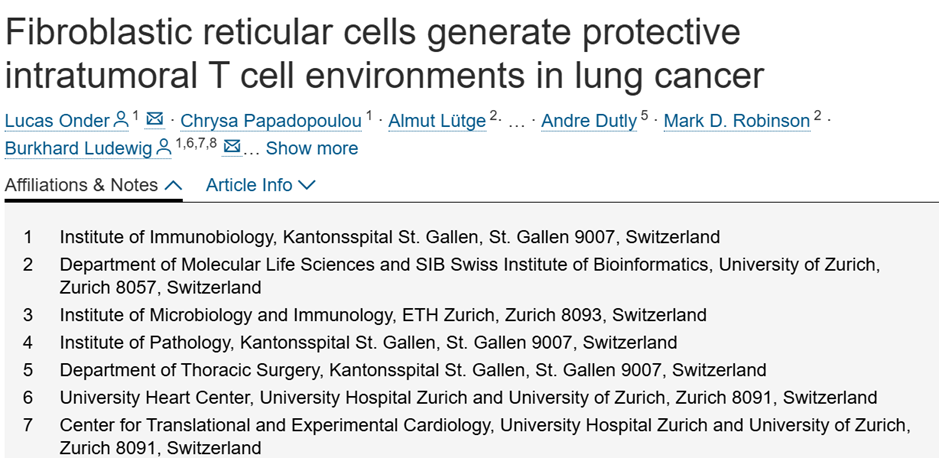
Stringent control of T cell activity in the tumor microenvironment is essential for the generation of protective antitumor immunity. However, the identity, differentiation, and functions of the cells that create critical fibroblastic niches promoting tumor-infiltrating T cells remain elusive. Here, we show that CCL19-expressing fibroblastic reticular cells (FRCs) generate interconnected T cell environments (TEs) in human non-small cell lung cancer, including tertiary lymphoid structures and T cell tracks. Analysis of the FRC-T cell interactome in TEs indicated molecular networks regulating niche-specific differentiation of CCL19-expressing fibroblasts and T cell activation pathways. Single-cell transcriptomics and cell fate-mapping analyses in mice confirmed that FRCs in TEs originate from mural and adventitial progenitors. Ablation of intratumoral FRC precursors decreased antitumor T cell activity, resulting in reduced tumor control during coronavirus vector-based immunotherapy. In summary, specialized FRC niches in the tumor microenvironment govern the quality and extent of antitumor T cell immunity.
在肿瘤微环境中严格调控T细胞活性对于产生保护性抗肿瘤免疫至关重要。然而,那些形成肿瘤浸润T细胞的关键成纤维细胞生态位的细胞身份、分化及功能仍不明确。本研究表明,在人类非小细胞肺癌中,表达CCL19的成纤维细胞网状细胞(FRCs)可形成相互连接的T细胞环境(TEs),包括三级淋巴结构和T细胞轨迹。对TE中FRC-T细胞相互作用组的分析,揭示了调控CCL19表达成纤维细胞生态位特异性分化及T细胞激活通路的分子网络。小鼠单细胞转录组学及细胞命运图谱分析证实,TE中的FRCs起源于血管周细胞和外膜祖细胞。清除肿瘤内FRC前体细胞会降低抗肿瘤T细胞活性,导致基于冠状病毒载体的免疫治疗期间肿瘤控制能力下降。总之,肿瘤微环境中特化的FRC生态位调控着抗肿瘤T细胞免疫的质量和程度。
Mechano-dependent sorbitol accumulation supports biomolecular condensate
机械依赖性山梨醇积累支持生物分子凝聚
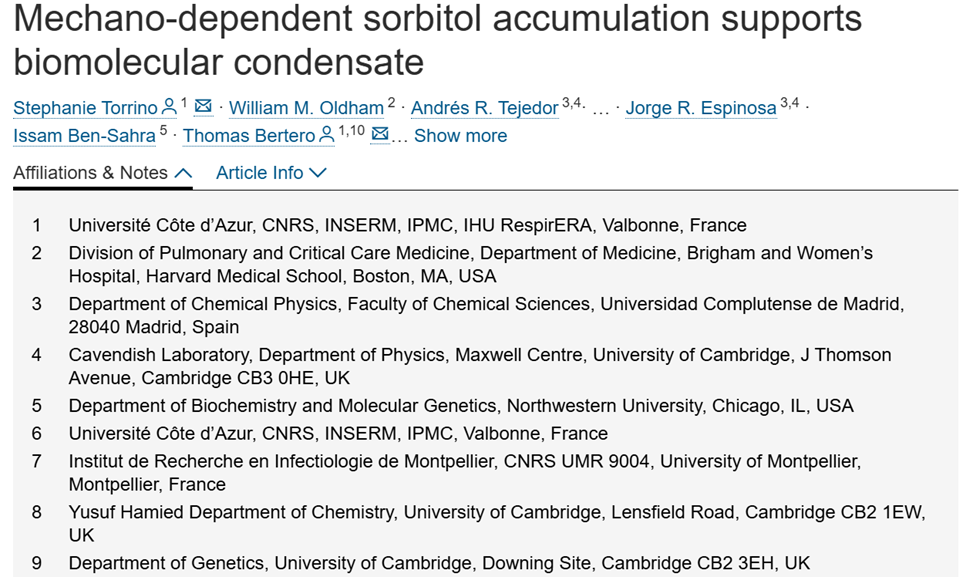
Condensed droplets of protein regulate many cellular functions, yet the physiological conditions regulating their formation remain largely unexplored. Increasing our understanding of these mechanisms is paramount, as failure to control condensate formation and dynamics can lead to many diseases. Here, we provide evidence that matrix stiffening promotes biomolecular condensation in vivo. We demonstrate that the extracellular matrix links mechanical cues with the control of glucose metabolism to sorbitol. In turn, sorbitol acts as a natural crowding agent to promote biomolecular condensation. Using in silico simulations and in vitro assays, we establish that variations in the physiological range of sorbitol concentrations, but not glucose concentrations, are sufficient to regulate biomolecular condensates. Accordingly, pharmacological and genetic manipulation of intracellular sorbitol concentration modulates biomolecular condensates in breast cancer—a mechano-dependent disease. We propose that sorbitol is a mechanosensitive metabolite enabling protein condensation to control mechano-regulated cellular functions.
蛋白质凝聚液滴调控多种细胞功能,但其形成所依赖的生理条件在很大程度上仍未被探索。由于失控的凝聚体形成和动态变化会导致多种疾病,因此深入理解这些调控机制至关重要。本文中,研究者证实了基质硬化在体内能够促进生物分子凝聚。研究发现,细胞外基质通过将机械信号与葡萄糖代谢向山梨醇的转化过程相耦联,进而促使山梨醇作为天然拥挤剂促进生物分子凝聚。通过计算机模拟和体外实验,研究者证实山梨醇(而非葡萄糖)在生理浓度范围内的波动足以调控生物分子凝聚体。基于此,在乳腺癌(一种机械依赖性病理状态)中,通过药理学和遗传学手段调控细胞内山梨醇浓度可有效调节生物分子凝聚体。研究者提出山梨醇作为机械敏感代谢物,通过介导蛋白质凝聚来调控机械信号响应的细胞功能。
snoRNA-facilitated protein secretion revealed by transcriptome-wide snoRNA target identification
基于全转录组snoRNA靶标鉴定揭示snoRNA介导的蛋白质分泌机制

Small nucleolar RNAs (snoRNAs) are non-coding RNAs known for guiding RNA modifications, including 2′-O-methylation (Nm) and pseudouridine (Ψ). While snoRNAs may also interact with other RNAs, such as mRNA, the full repertoire of RNAs targeted by snoRNA remains elusive due to the lack of effective technologies that identify snoRNA targets transcriptome wide. Here, we develop a chemical crosslinking-based approach that comprehensively detects cellular RNA targets of snoRNAs, yielding thousands of previously unrecognized snoRNA-mRNA interactions in human cells and mouse brain tissues. Many interactions occur outside of snoRNA-guided RNA modification sites, hinting at non-canonical functions beyond RNA modification. We find that one of these snoRNAs, SNORA73, targets mRNAs that encode secretory proteins and membrane proteins. SNORA73 also interacts with 7SL RNA, part of the signal recognition particle (SRP) required for protein secretion. The mRNA-SNORA73-7SL RNA interactions enhance the association of the SNORA73-target mRNAs with SRP, thereby facilitating the secretion of encoded proteins.
小核仁RNA(snoRNAs)是一类非编码RNA,以指导RNA修饰(包括2′-O-甲基化(Nm)和假尿嘧啶(Ψ))而闻名。尽管snoRNAs也可能与其他RNA(如mRNA)相互作用,但由于缺乏在全转录组范围内识别snoRNA靶标的有效技术,snoRNA靶向的RNA全貌仍不明确。本研究开发了一种基于化学交联的方法,可全面检测snoRNA的细胞RNA靶标,在人类细胞和小鼠脑组织中发现了数千种先前未被识别的snoRNA-mRNA相互作用。许多相互作用发生在snoRNA指导的RNA修饰位点之外,暗示其可能具有超越RNA修饰的非经典功能。研究者发现其中一个snoRNA——SNORA73,能够靶向编码分泌蛋白和膜蛋白的mRNA。SNORA73还与7SL RNA(蛋白质分泌所需信号识别颗粒(SRP)的组成部分)发生相互作用。mRNA-SNORA73-7SL RNA的相互作用增强了SNORA73靶向mRNA与SRP的结合,从而促进编码蛋白的分泌。
Periodic ER-plasma membrane junctions support long-range Ca2+ signal integration in dendrites
周期性内质网-质膜连接结构支持树突中长程Ca²⁺信号整合
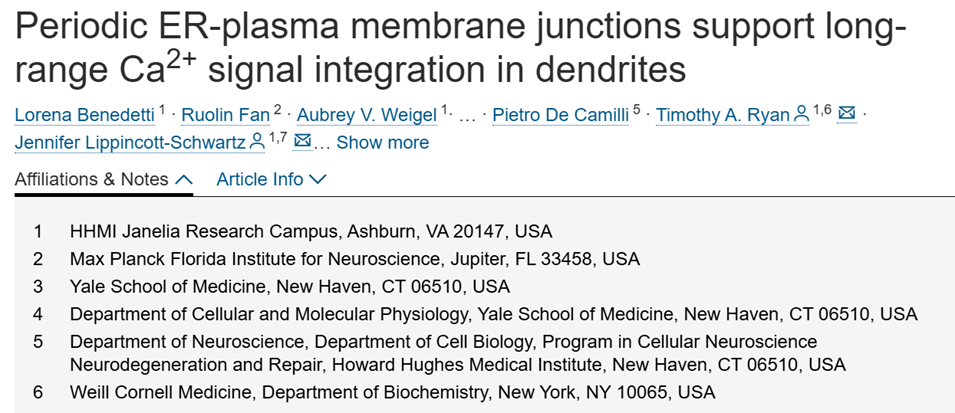
Neuronal dendrites must relay synaptic inputs over long distances, but the mechanisms by which activity-evoked intracellular signals propagate over macroscopic distances remain unclear. Here, we discovered a system of periodically arranged endoplasmic reticulum-plasma membrane (ER-PM) junctions tiling the plasma membrane of dendrites at ∼1 μm intervals, interlinked by a meshwork of ER tubules patterned in a ladder-like array. Populated with Junctophilin-linked plasma membrane voltage-gated Ca2+ channels and ER Ca2+-release channels (ryanodine receptors), ER-PM junctions are hubs for ER-PM crosstalk, fine-tuning of Ca2+ homeostasis, and local activation of the Ca2+/calmodulin-dependent protein kinase II. Local spine stimulation activates the Ca2+ modulatory machinery, facilitating signal transmission and ryanodine-receptor-dependent Ca2+ release at ER-PM junctions over 20 μm away. Thus, interconnected ER-PM junctions support signal propagation and Ca2+ release from the spine-adjacent ER. The capacity of this subcellular architecture to modify both local and distant membrane-proximal biochemistry potentially contributes to dendritic computations.
神经元的树突需要长距离传递突触输入信号,但活动诱发的细胞内信号如何在宏观距离传播的机制仍不明确。本研究发现,在树突质膜上存在一种以约1微米间隔周期性排列的内质网-质膜(ER-PM)连接结构,这些结构通过呈梯状排列的ER小管网相互连接。这些ER-PM连接结构富含由Junctophilin蛋白锚定的质膜电压门控钙通道和ER钙释放通道(兰尼碱受体),成为ER-PM交互作用的枢纽,可精确调控钙稳态并局部激活Ca2+/钙调蛋白依赖性蛋白激酶II。局部树突棘刺激可激活钙调节机制,促进信号传递并在20微米外的ER-PM连接处通过兰尼碱受体依赖的方式进行钙释放。因此,相互连接的ER-PM连接结构支持棘旁内质网信号传播和钙释放。这种亚细胞结构通过调控局部和远端膜近端生物化学反应的能力,可能对树突计算功能具有重要贡献。
Human hippocampal CA3 uses specific functional connectivity rules for efficient associative memory
人类海马CA3区通过特定的功能性连接规则实现高效联想记忆
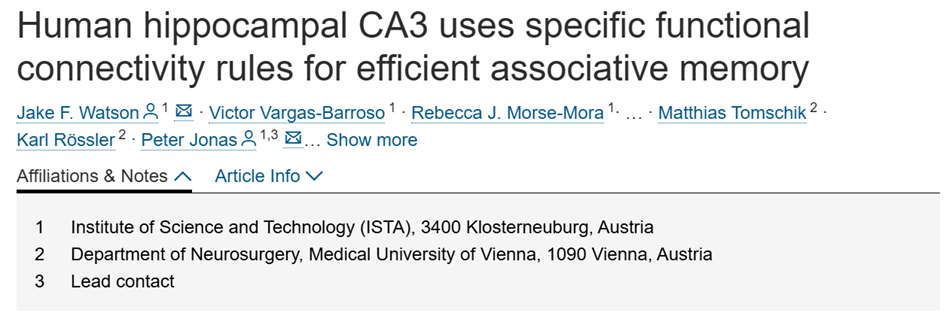
Our brain has remarkable computational power, generating sophisticated behaviors, storing memories over an individual’s lifetime, and producing higher cognitive functions. However, little of our neuroscience knowledge covers the human brain. Is this organ truly unique, or is it a scaled version of the extensively studied rodent brain? Combining multicellular patch-clamp recording with expansion-based superresolution microscopy and full-scale modeling, we determined the cellular and microcircuit properties of the human hippocampal CA3 region, a fundamental circuit for memory storage. In contrast to neocortical networks, human hippocampal CA3 displayed sparse connectivity, providing a circuit architecture that maximizes associational power. Human synapses showed unique reliability, high precision, and long integration times, exhibiting both species- and circuit-specific properties. Together with expanded neuronal numbers, these circuit characteristics greatly enhanced the memory storage capacity of CA3. Our results reveal distinct microcircuit properties of the human hippocampus and begin to unravel the inner workings of our most complex organ.
我们的脑具有非凡的计算能力,能够产生复杂的行为、存储个体一生的记忆并实现高级认知功能。然而,现有的神经科学知识对人类大脑的覆盖极为有限。这一器官是否真正独特,抑或仅是已被广泛研究的啮齿类动物脑的放大版本?通过将多细胞膜片钳记录技术与基于膨胀的超分辨率显微成像及全尺度建模相结合,研究者解析了人类海马CA3区的细胞与微环路特性——这一关键环路是记忆存储的基础。与新皮质网络不同,人类海马CA3区呈现出稀疏连接性,这种环路结构使联想能力最大化。人类突触展现出独特的可靠性、高精度及长整合时间,兼具物种与环路特异性。结合神经元数量的扩增,这些环路特性显著提升了CA3区的记忆存储容量。此研究揭示了人类海马区独特的微环路特性,并开始解析这一最复杂器官的内在运作机制。
Digital phenotyping from wearables using AI characterizes psychiatric disorders and identifies genetic associations
利用人工智能从可穿戴设备进行数字表型分析,描述精神疾病的特征并确定遗传关联
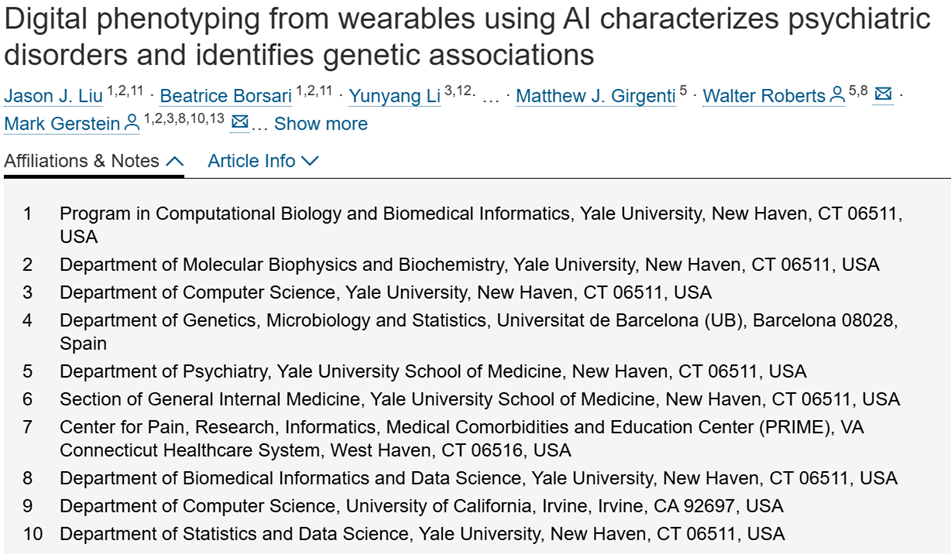
Psychiatric disorders are influenced by genetic and environmental factors. However, their study is hindered by limitations on precisely characterizing human behavior. New technologies such as wearable sensors show promise in surmounting these limitations in that they measure heterogeneous behavior in a quantitative and unbiased fashion. Here, we analyze wearable and genetic data from the Adolescent Brain Cognitive Development (ABCD) study. Leveraging >250 wearable-derived features as digital phenotypes, we show that an interpretable AI framework can objectively classify adolescents with psychiatric disorders more accurately than previously possible. To relate digital phenotypes to the underlying genetics, we show how they can be employed in univariate and multivariate genome-wide association studies (GWASs). Doing so, we identify 16 significant genetic loci and 37 psychiatric-associated genes, including ELFN1 and ADORA3, demonstrating that continuous, wearable-derived features give greater detection power than traditional case-control GWASs. Overall, we show how wearable technology can help uncover new linkages between behavior and genetics.
精神疾病受遗传和环境因素共同影响,然而由于对人类行为进行精准表征存在困难,对精神疾病的研究存在限制。新兴技术如可穿戴传感器为突破这一瓶颈提供了可能,因其能以定量、无偏的方式测量异质性行为特征。本研究基于青少年脑认知发展(Adolescent Brain Cognitive Development,ABCD)研究的可穿戴设备与遗传数据,利用来自超过250项可穿戴设备的特征作为数字表型,证明可解释性的人工智能框架能够以前所未有的准确度对青少年精神疾病进行客观分类。为探究数字表型与遗传基础的关系,研究者将其应用于单变量与多变量全基因组关联研究(GWAS),成功鉴定出16个显著遗传位点和37个精神疾病相关基因(如ELFN1和ADORA3),表明持续性的可穿戴设备记录的特征比传统病例对照GWAS具有更强的检测效力。总体而言,本研究揭示了可穿戴技术如何帮助解析行为与遗传学之间的新关联。
Engineering source-sink relations by prime editing confers heat-stress resilience in tomato and rice
通过先导编辑工程化源库关系赋予番茄和水稻耐热性
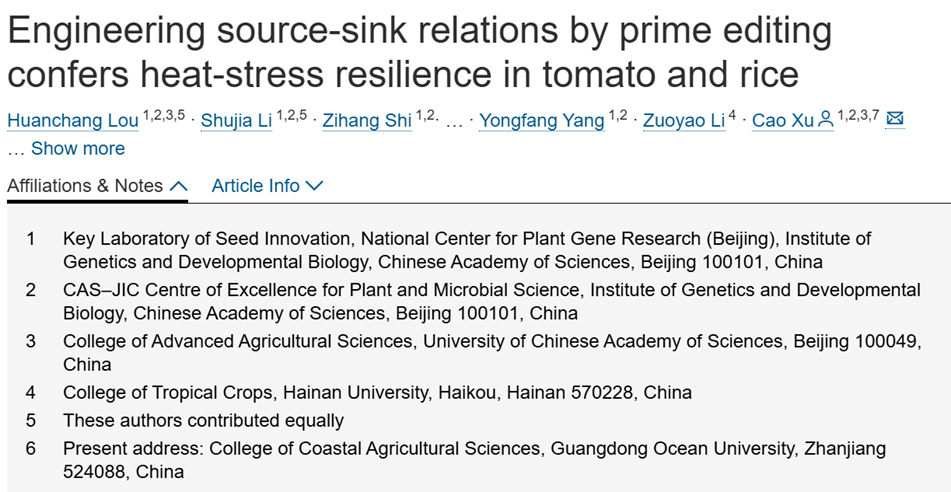
A 2°C climate-warming scenario is expected to further exacerbate average crop losses by 3%–13%, yet few heat-tolerant staple-crop varieties are available toward meeting future food demands. Here, we develop high-efficiency prime-editing tools to precisely knockin a 10-bp heat-shock element (HSE) into promoters of cell-wall-invertase genes (CWINs) in elite rice and tomato cultivars. HSE insertion endows CWINs with heat-responsive upregulation in both controlled and field environments to enhance carbon partitioning to grain and fruits, resulting in per-plot yield increases of 25% in rice cultivar Zhonghua11 and 33% in tomato cultivar Ailsa Craig over heat-stressed controls, without fruit quality penalties. Up to 41% of heat-induced grain losses were rescued in rice. Beyond a prime-editing system for tweaking gene expression by efficiently delivering bespoke changes into crop genomes, we demonstrate broad and robust utility for targeted knockin of cis-regulatory elements to optimize source-sink relations and boost crop climate resilience.
在2°C气候变暖情景下,预计作物平均损失将因高温进一步加剧3%-13%,然而目前可用于应对未来粮食需求的耐热主粮作物品种却十分有限。本研究开发了高效引物编辑工具,成功将10-bp的热激元件(HSE)精准敲入水稻优良品种"中花11号"和番茄品种"Ailsa Craig"的细胞壁转化酶基因(CWINs)启动子区域。HSE插入使CWINs在受控环境与田间条件下均表现出热响应性上调,显著增强碳向籽粒和果实的分配:相较于热胁迫对照组,水稻小区产量提升25%,番茄小区产量提升33%,且果实品质未受影响。水稻中最高可挽回41%的热致产量损失。本研究不仅构建了通过精准基因组编辑调控基因表达的引物编辑系统,更展示了通过靶向敲入顺式调控元件优化源-库关系、增强作物气候适应力的广泛适用性。
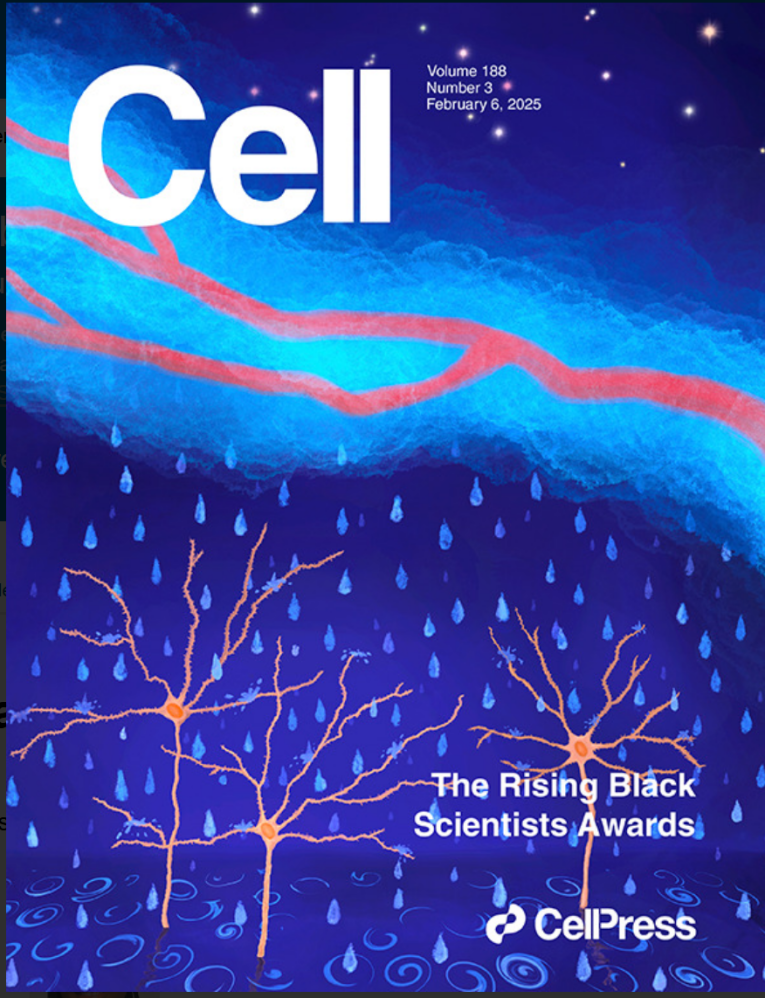
Feb 06, 2025 Volume 188 Issue 3p573-868
2025年2月6日此期共发表Commentary 1篇,Short Article 1篇,Articles 13篇,Resources 3篇。
1.Norepinephrine-mediated slow vasomotion drives glymphatic clearance during sleep
去甲肾上腺素介导的缓慢血管运动驱动睡眠期间的类淋巴系统清除
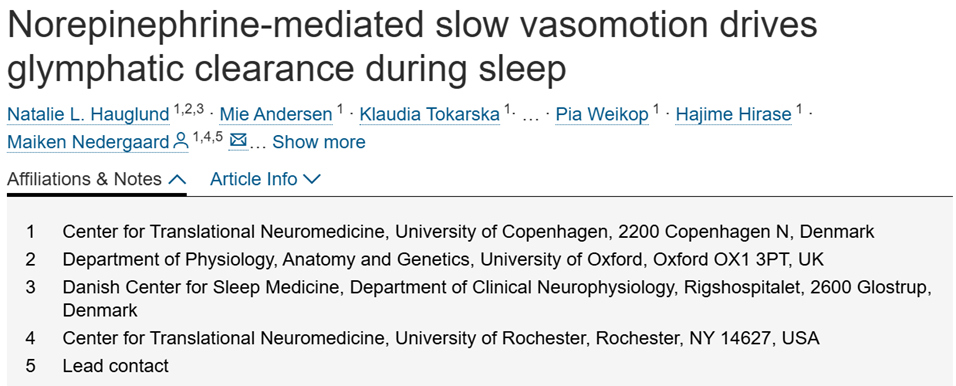
As the brain transitions from wakefulness to sleep, processing of external information diminishes while restorative processes, such as glymphatic removal of waste products, are activated. Yet, it is not known what drives brain clearance during sleep. We here employed an array of technologies and identified tightly synchronized oscillations in norepinephrine, cerebral blood volume, and cerebrospinal fluid (CSF) as the strongest predictors of glymphatic clearance during NREM sleep. Optogenetic stimulation of the locus coeruleus induced anti-correlated changes in vasomotion and CSF signal. Furthermore, stimulation of arterial oscillations enhanced CSF inflow, demonstrating that vasomotion acts as a pump driving CSF into the brain. On the contrary, the sleep aid zolpidem suppressed norepinephrine oscillations and glymphatic flow, highlighting the critical role of norepinephrine-driven vascular dynamics in brain clearance. Thus, the micro-architectural organization of NREM sleep, driven by norepinephrine fluctuations and vascular dynamics, is a key determinant for glymphatic clearance.
当大脑从清醒状态过渡到睡眠时,对外部信息的处理逐渐减弱,而诸如类淋巴系统清除代谢废物等修复性过程则被激活。然而,驱动睡眠期间大脑清除的机制尚不明确。本研究通过多种技术手段,发现去甲肾上腺素、脑血容量和脑脊液(CSF)的紧密同步振荡是非快速眼动(NREM)睡眠期间类淋巴清除的最强预测因子。对蓝斑核进行光遗传学刺激可诱导血管运动和脑脊液信号的反向关联变化。此外,刺激动脉振荡可增强脑脊液流入,表明血管运动作为泵驱动脑脊液进入大脑。相反,助眠药物唑吡坦抑制了去甲肾上腺素振荡和类淋巴流,凸显了去甲肾上腺素驱动的血管动力学在脑清除中的关键作用。因此,由去甲肾上腺素波动和血管动力学驱动的NREM睡眠微观结构组织,是类淋巴清除的核心决定因素。
2.Long somatic DNA-repeat expansion drives neurodegeneration in Huntington’s disease
体细胞长DNA重复序列的过度扩张驱动亨廷顿病神经退行性变
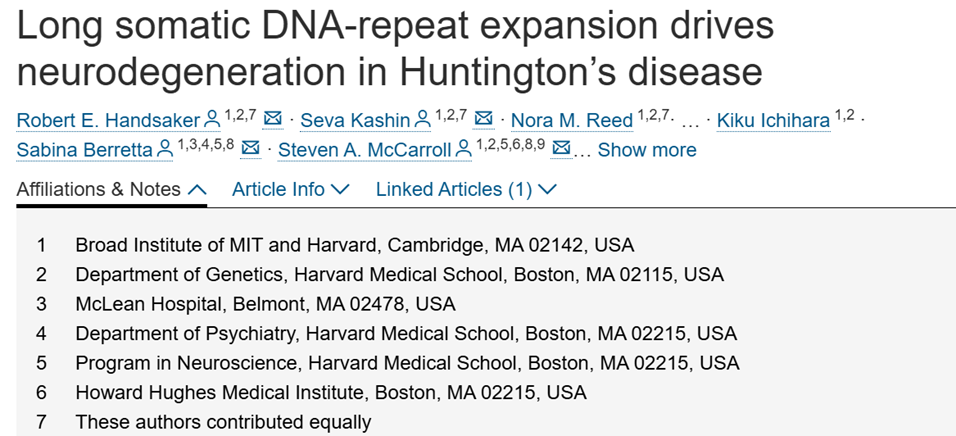
In Huntington’s disease (HD), striatal projection neurons (SPNs) degenerate during midlife; the core biological question involves how the disease-causing DNA repeat (CAG)n in the huntingtin (HTT) gene leads to neurodegeneration after decades of biological latency. We developed a single-cell method for measuring this repeat’s length alongside genome-wide RNA expression. We found that the HTT CAG repeat expands somatically from 40–45 to 100–500+ CAGs in SPNs. Somatic expansion from 40 to 150 CAGs had no apparent cell-autonomous effect, but SPNs with 150–500+ CAGs lost positive and then negative features of neuronal identity, de-repressed senescence/apoptosis genes, and were lost. Our results suggest that somatic repeat expansion beyond 150 CAGs causes SPNs to degenerate quickly and asynchronously. We conclude that in HD, at any one time, most neurons have an innocuous but unstable HTT gene and that HD pathogenesis is a DNA process for almost all of a neuron’s life.
在亨廷顿病(HD)中,纹状体投射神经元(SPNs)会在中年时期发生退行性病变;核心生物学问题在于亨廷顿蛋白(HTT)基因中致病的DNA重复序列(CAG)n如何经过数十年的生物学潜伏期后引发神经退行性变。研究者开发了一种单细胞方法,可在测量该重复序列长度的同时分析全基因组RNA表达。研究发现,HTT基因的CAG重复序列在SPNs中会经历体细胞扩展,从40-45个CAG重复扩展到100-500+个CAG重复。当体细胞扩展从40个CAG重复增至150个CAG重复时,未观察到明显的细胞自主效应,但当SPNs的CAG重复达到150-500+个范围时,神经元身份的正向特征逐渐丧失,随后负向特征也消失,同时衰老/凋亡基因的抑制被解除,最终导致神经元死亡。研究结果表明,体细胞CAG重复扩展超过150个会导致SPNs快速且不同步地退化。研究者得出结论:在HD病程中,任一时刻大多数神经元都携带无害但不稳定的HTT基因,且亨廷顿病的发病机制几乎贯穿神经元的整个生命周期,是一个DNA层面的动态过程。
3.Trans-ancestry genome-wide study of depression identifies 697 associations implicating cell types and pharmacotherapies
在一项跨种族全基因组抑郁症研究中,研究者发现了697个关联信号,揭示了特定细胞类型与药物治疗机制

In a genome-wide association study (GWAS) meta-analysis of 688,808 individuals with major depression (MD) and 4,364,225 controls from 29 countries across diverse and admixed ancestries, we identify 697 associations at 635 loci, 293 of which are novel. Using fine-mapping and functional tools, we find 308 high-confidence gene associations and enrichment of postsynaptic density and receptor clustering. A neural cell-type enrichment analysis utilizing single-cell data implicates excitatory, inhibitory, and medium spiny neurons and the involvement of amygdala neurons in both mouse and human single-cell analyses. The associations are enriched for antidepressant targets and provide potential repurposing opportunities. Polygenic scores trained using European or multi-ancestry data predicted MD status across all ancestries, explaining up to 5.8% of MD liability variance in Europeans. These findings advance our global understanding of MD and reveal biological targets that may be used to target and develop pharmacotherapies addressing the unmet need for effective treatment.
在一项针对重度抑郁症(MD)的全基因组关联研究(GWAS)荟萃分析中,研究者纳入了来自29个国家、具有多样性和混合血统的688,808例MD患者和4,364,225例对照个体。研究共发现635个基因位点上的697个关联信号,其中293个为新发现的关联信号。通过精细定位和功能分析工具,研究者确定了308个高置信度基因关联,并发现突触后密度和受体聚集的显著富集。基于单细胞数据的神经细胞类型富集分析显示,兴奋性神经元、抑制性神经元、中型多棘神经元以及杏仁核神经元在人类和小鼠单细胞分析中均具有关联性。这些关联信号在抗抑郁药物靶点中显著富集,为药物再利用提供了潜在机会。使用欧洲或多种族数据训练的多基因评分可预测所有种族的MD状态,在欧洲人群中最高可解释5.8%的MD易感性方差。这些发现深化了全球对MD的认知,并揭示了可用于开发靶向治疗的生物学靶点,为解决当前有效治疗手段不足的难题提供了新方向。
4.Evolutionary study and structural basis of proton sensing by Mus GPR4 and Xenopus GPR4
Mus GPR4与热带爪蟾GPR4质子感应的进化研究及结构基础
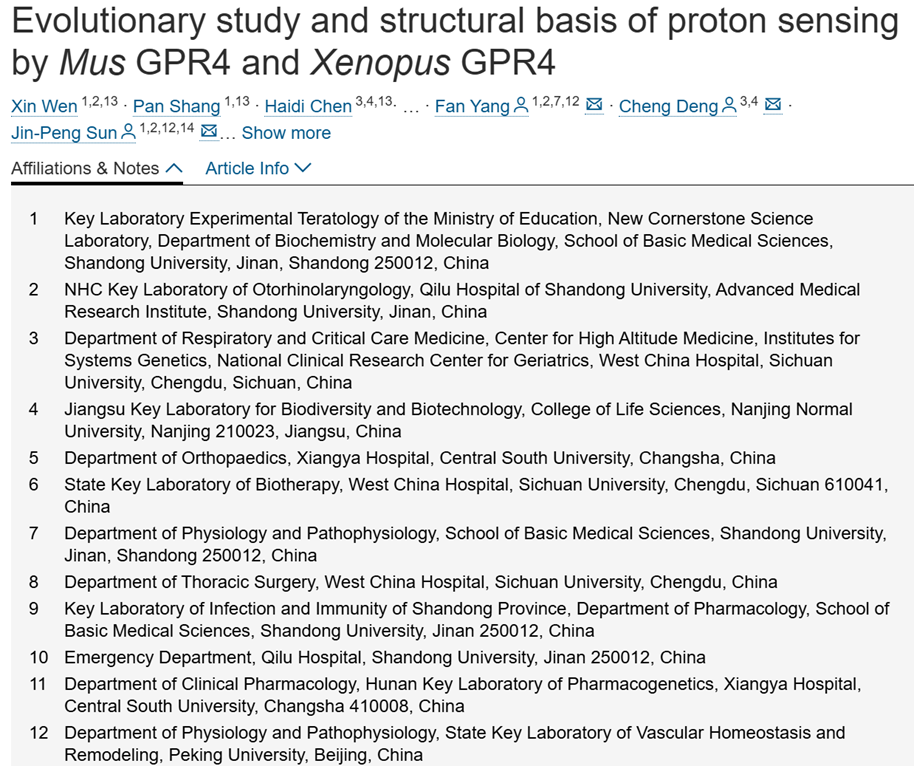
Animals have evolved pH-sensing membrane receptors, such as G-protein-coupled receptor 4 (GPR4), to monitor pH changes related to their physiology and generate adaptive reactions. However, the evolutionary trajectory and structural mechanism of proton sensing by GPR4 remain unresolved. Here, we observed a positive correlation between the optimal pH of GPR4 activity and the blood pH range across different species. By solving 7-cryoelectron microscopy (cryo-EM) structures of Xenopus tropicalis GPR4 (xtGPR4) and Mus musculus GPR4 (mmGPR4) under varying pH conditions, we identified that protonation of HECL2-45.47 and H7.36 enabled polar network establishment and tighter association between the extracellular loop 2 (ECL2) and 7 transmembrane (7TM) domain, as well as a conserved propagating path, which are common mechanisms underlying protonation-induced GPR4 activation across different species. Moreover, protonation of distinct extracellular HECL2-45.41 contributed to the more acidic optimal pH range of xtGPR4. Overall, our study revealed common and distinct mechanisms of proton sensing by GPR4, from a structural, functional, and evolutionary perspective.
动物进化出pH感应膜受体(如G蛋白偶联受体4,GPR4)以监测与其生理相关的pH变化并产生适应性反应。然而,GPR4质子感应的进化轨迹和结构机制仍未阐明。本研究发现不同物种中GPR4活性的最适pH与其血液pH范围呈正相关。通过解析热带爪蟾GPR4(xtGPR4)和小鼠GPR4(Mus musculus GPR4,mmGPR4)在不同pH条件下的7个冷冻电镜结构,研究者发现HECL2-45.47和H7.36的质子化能够建立极性网络,促进胞外第二环(ECL2)与7次跨膜结构域(7TM)的紧密结合,并形成保守的传导路径——这些是跨物种质子化激活GPR4的共同机制。此外,胞外HECL2-45.41的特异性质子化导致xtGPR4具有更偏酸性的最适pH范围。本研究从结构、功能和进化角度揭示了GPR4质子感应的共性与特性机制。
Molecular basis of proton sensing by G protein-coupled receptors
G蛋白偶联受体的质子感知分子机制
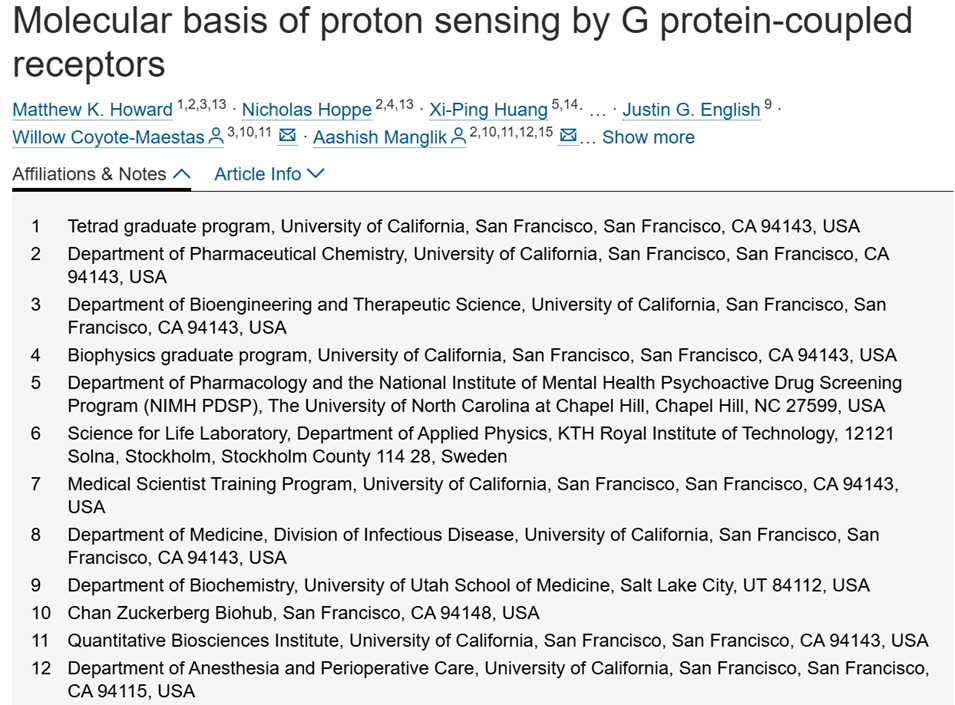
Three proton-sensing G protein-coupled receptors (GPCRs)—GPR4, GPR65, and GPR68—respond to extracellular pH to regulate diverse physiology. How protons activate these receptors is poorly understood. We determined cryogenic-electron microscopy (cryo-EM) structures of each receptor to understand the spatial arrangement of proton-sensing residues. Using deep mutational scanning (DMS), we determined the functional importance of every residue in GPR68 activation by generating ∼9,500 mutants and measuring their effects on signaling and surface expression. Constant-pH molecular dynamics simulations provided insights into the conformational landscape and protonation patterns of key residues. This unbiased approach revealed that, unlike other proton-sensitive channels and receptors, no single site is critical for proton recognition. Instead, a network of titratable residues extends from the extracellular surface to the transmembrane region, converging on canonical motifs to activate proton-sensing GPCRs. Our approach integrating structure, simulations, and unbiased functional interrogation provides a framework for understanding GPCR signaling complexity.
三种质子感应G蛋白偶联受体(GPR4、GPR65和GPR68)通过响应细胞外pH值调控多种生理功能,但其质子激活机制尚不明确。本研究通过冷冻电镜(cryo-EM)解析了各受体结构以揭示质子感应残基的空间排布。采用深度突变扫描(DMS)技术,研究者构建了约9500个GPR68突变体并检测其信号传导与表面表达的影响,系统评估了每个残基在受体激活中的功能重要性。恒pH分子动力学模拟揭示了关键残基的构象动态与质子化模式。这种无偏研究方法表明,与其他质子敏感通道和受体不同,这些GPCR的质子识别不依赖单一关键位点,而是通过从胞外表面延伸至跨膜区的可滴定残基网络,汇聚于经典结构基序实现激活。本研究整合结构解析、模拟计算与系统性功能验证的研究框架,为解析GPCR信号传导复杂性提供了新范式。
Structural and functional analysis of the Nipah virus polymerase complex
尼帕病毒聚合酶复合体的结构与功能分析
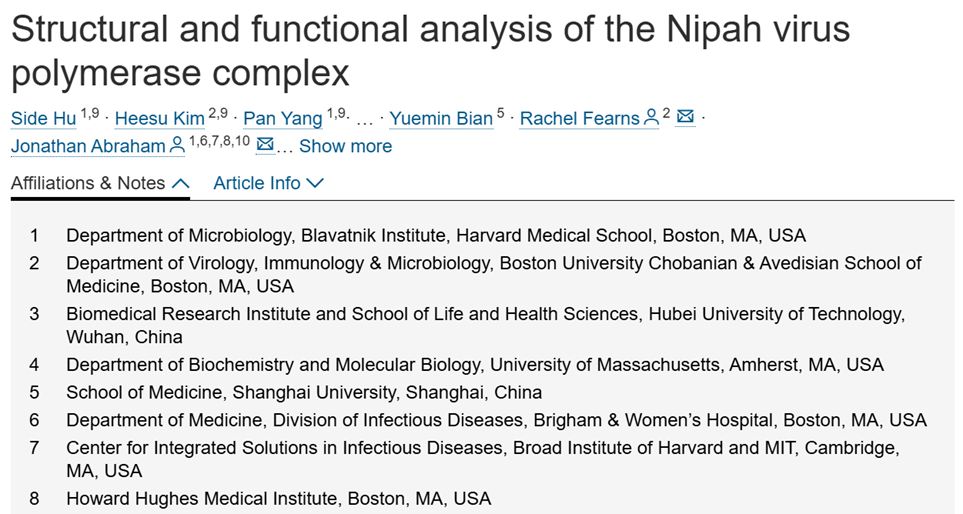
Nipah virus (NiV) is a bat-borne, zoonotic RNA virus that is highly pathogenic in humans. The NiV polymerase, which mediates viral genome replication and mRNA transcription, is a promising drug target. We determined the cryoelectron microscopy (cryo-EM) structure of the NiV polymerase complex, comprising the large protein (L) and phosphoprotein (P), and performed structural, biophysical, and in-depth functional analyses of the NiV polymerase. The L protein assembles with a long P tetrameric coiled-coil that is capped by a bundle of ⍺-helices that we show are likely dynamic in solution. Docking studies with a known L inhibitor clarify mechanisms of antiviral drug resistance. In addition, we identified L protein features that are required for both transcription and RNA replication and mutations that have a greater impact on RNA replication than on transcription. Our findings have the potential to aid in the rational development of drugs to combat NiV infection.
尼帕病毒(NiV)是一种由蝙蝠传播的人畜共患RNA病毒,对人类具有高致病性。尼帕病毒聚合酶(L蛋白)负责病毒基因组复制和mRNA转录,是潜在的药物靶点。本研究通过冷冻电镜(cryo-EM)解析了由L蛋白和磷蛋白(P)组成的尼帕病毒聚合酶复合体结构,并对其进行了结构、生物物理及深入的功能分析。研究发现,L蛋白与P蛋白四聚体卷曲螺旋长链结合,其末端由一组α螺旋束覆盖,且这些α螺旋在溶液中可能具有动态特性。通过已知L蛋白抑制剂的分子对接研究,揭示了抗病毒药物耐药性的机制。此外,研究还鉴定了L蛋白中同时影响转录和RNA复制的关键结构特征,以及某些对RNA复制影响显著大于转录的突变位点。这些发现为合理开发抗尼帕病毒感染药物提供了重要依据。
Nucleocapsid assembly drives Ebola viral factory maturation and dispersion
核衣壳组装驱动埃博拉病毒工厂成熟与分散
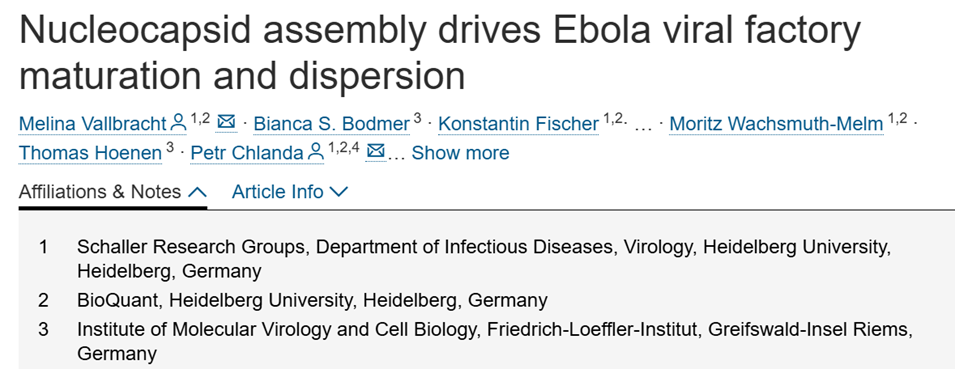
Replication and genome encapsidation of many negative-sense RNA viruses take place in virus-induced membraneless organelles termed viral factories (VFs). Although liquid properties of VFs are believed to control the transition from genome replication to nucleocapsid (NC) assembly, VF maturation and interactions with the cellular environment remain elusive. Here, we apply in situ cryo-correlative light and electron tomography to follow NC assembly and changes in VF morphology and their liquid properties during Ebola virus infection. We show that viral NCs transition from loosely packed helical assemblies in early VFs to compact cylinders that arrange into highly organized parallel bundles later in infection. Early VFs associate with intermediate filaments and are devoid of other host material but become progressively accessible to cellular components. Our data suggest that this process is coupled to VF solidification, loss of sphericity, and dispersion and promotes cytoplasmic exposure of NCs to facilitate their transport to budding sites.
许多负链RNA病毒的复制和基因组封装过程发生在病毒诱导的无膜细胞器——病毒工厂(VFs)中。尽管病毒工厂的液态特性被认为控制着从基因组复制到核衣壳(NC)组装的转变,但其成熟过程与细胞环境的相互作用仍不明确。本研究采用原位冷冻相关光镜和电子断层扫描技术,追踪埃博拉病毒感染过程中核衣壳的组装过程以及病毒工厂形态和液态特性的变化。研究者发现病毒核衣壳在早期病毒工厂中呈现松散堆积的螺旋组装形式,随着感染进程逐渐转变为致密的圆柱体结构,并最终排列成高度有序的平行束状结构。早期病毒工厂与中间丝相连且不含其他宿主物质,但随着感染进展逐渐允许细胞成分进入。数据表明该过程与病毒工厂的固化、球体形态的丧失及分散相关,并促进核衣壳在胞质暴露以利于其向出芽位点的运输。
DNA end sensing and cleavage by the Shedu anti-phage defense system
Shedu抗噬菌体防御系统的 DNA 末端感应和切割功能

The detection of molecular patterns associated with invading pathogens is a hallmark of innate immune systems. Prokaryotes deploy sophisticated host defense mechanisms in innate anti-phage immunity. Shedu is a single-component defense system comprising a putative nuclease SduA. Here, we report cryoelectron microscopy (cryo-EM) structures of apo- and double-stranded DNA (dsDNA)-bound tetrameric SduA assemblies, revealing that the N-terminal domains of SduA form a clamp that recognizes free DNA ends. End binding positions the DNA over the PD-(D/E)XK nuclease domain, resulting in dsDNA nicking at a fixed distance from the 5′ end. The end-directed DNA nicking activity of Shedu prevents propagation of linear DNA in vivo. Finally, we show that phages escape Shedu immunity by suppressing their recombination-dependent DNA replication pathway. Taken together, these results define the antiviral mechanism of Shedu systems, underlining the paradigm that recognition of pathogen-specific nucleic acid structures is a conserved feature of innate immunity across all domains of life.
对入侵病原体相关分子模式的识别是先天免疫系统的标志。原核生物在先天抗噬菌体免疫中部署了复杂的宿主防御机制。Shedu是一种单组分防御系统,包含一个假定的核酸酶SduA。本文报道了无配体状态和双链DNA(dsDNA)结合状态下四聚体SduA组装的冷冻电镜结构,揭示了SduA的N端结构域形成钳状结构识别游离DNA末端。末端结合使DNA定位于PD-(D/E)XK核酸酶结构域上方,导致在距离5‘端固定位置处对双链DNA进行切割。Shedu的末端导向DNA切割活性可阻止线性DNA在体内的增殖。最后,本研究发现噬菌体通过抑制其重组依赖性DNA复制途径来逃逸Shedu免疫。综上所述,这些结果阐明了Shedu系统的抗病毒机制,强调了病原体特异性核酸结构识别是所有生命先天免疫中保守的特征。
High-resolution spatially resolved proteomics of complex tissues based on microfluidics and transfer learning
基于微流控技术和迁移学习的复杂组织高分辨率空间解析蛋白质组学
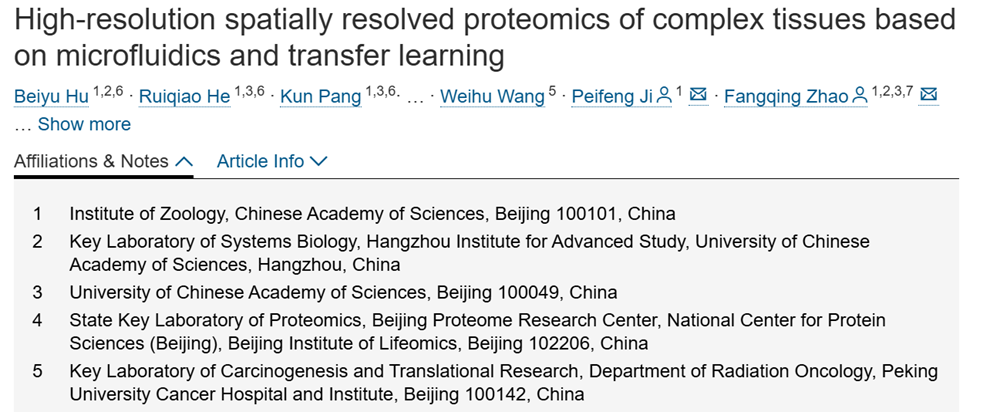
Despite recent advances in imaging- and antibody-based methods, achieving in-depth, high-resolution protein mapping across entire tissues remains a significant challenge in spatial proteomics. Here, we present parallel-flow projection and transfer learning across omics data (PLATO), an integrated framework combining microfluidics with deep learning to enable high-resolution mapping of thousands of proteins in whole tissue sections. We validated the PLATO framework by profiling the spatial proteome of the mouse cerebellum, identifying 2,564 protein groups in a single run. We then applied PLATO to rat villus and human breast cancer samples, achieving a spatial resolution of 25 μm and uncovering proteomic dynamics associated with disease states. This approach revealed spatially distinct tumor subtypes, identified key dysregulated proteins, and provided novel insights into the complexity of the tumor microenvironment. We believe that PLATO represents a transformative platform for exploring spatial proteomic regulation and its interplay with genetic and environmental factors.
尽管近年来基于成像和抗体的方法取得了进展,但在空间蛋白质组学领域,实现整个组织深度、高分辨率的蛋白质定位仍面临重大挑战。本研究提出了一种名为PLATO(并行流投影与跨组学迁移学习)的集成框架,通过结合微流控技术与深度学习,实现了全组织切片中数千种蛋白质的高分辨率定位。研究者通过对小鼠小脑空间蛋白质组的分析验证了PLATO框架,单次实验即鉴定出2,564个蛋白质组。随后将PLATO应用于大鼠肠绒毛和人类乳腺癌样本,实现了25微米的空间分辨率,并揭示了与疾病状态相关的蛋白质组学动态变化。该方法成功识别了空间分布差异的肿瘤亚型,发现了关键失调蛋白,并为肿瘤微环境的复杂性提供了新见解。研究者相信PLATO为探索空间蛋白质组调控及其与遗传、环境因素的相互作用构建了革命性研究平台。
SMC motor proteins extrude DNA asymmetrically and can switch directions
SMC马达蛋白以不对称方式挤压DNA,并能够动态转换方向
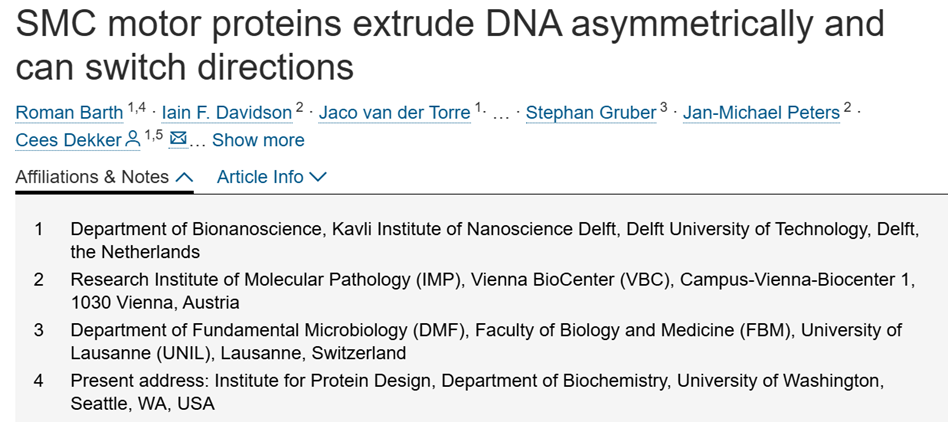
Structural maintenance of chromosomes (SMC) complexes organize the genome via DNA loop extrusion. Although some SMCs were reported to do so symmetrically, reeling DNA from both sides into the extruded DNA loop simultaneously, others perform loop extrusion asymmetrically toward one direction only. The mechanism underlying this variability remains unclear. Here, we examine the directionality of DNA loop extrusion by SMCs using in vitro single-molecule experiments. We find that cohesin and SMC5/6 do not reel in DNA from both sides, as reported before, but instead extrude DNA asymmetrically, although the direction can switch over time. Asymmetric DNA loop extrusion thus is the shared mechanism across all eukaryotic SMC complexes. For cohesin, direction switches strongly correlate with the turnover of the subunit NIPBL, during which DNA strand switching may occur. Apart from expanding by extrusion, loops frequently diffuse and shrink. The findings reveal that SMCs, surprisingly, can switch directions.
染色体结构维持(SMC)复合体通过DNA环挤压机制调控基因组空间组织。尽管先前研究报道部分SMC复合体以对称方式运作(即同时从DNA双链两侧进行收卷形成环结构),但其他复合体仅表现出单向不对称的环挤压特性,其方向性差异的分子机制尚不明确。本研究通过体外单分子实验探究SMC复合体的DNA环挤压方向性,发现黏连蛋白(cohesin)与SMC5/6复合体并非如先前报道的双向收卷机制,而是呈现不对称的DNA环挤压行为,且其方向性可随时间发生动态转换。这一发现表明,不对称DNA环挤压是所有真核生物SMC复合体的共性机制。对于黏连蛋白而言,其方向转换与NIPBL亚基的周期性解离/重结合过程密切相关,此过程中可能伴随DNA链的切换。此外,研究还观察到环结构除通过主动挤压扩展外,常伴随被动扩散与收缩现象。这些发现揭示了SMC复合体具有出人意料的动态方向调控能力。
Structural determinants of co-translational protein complex assembly
共翻译蛋白质复合体组装的结构决定因素
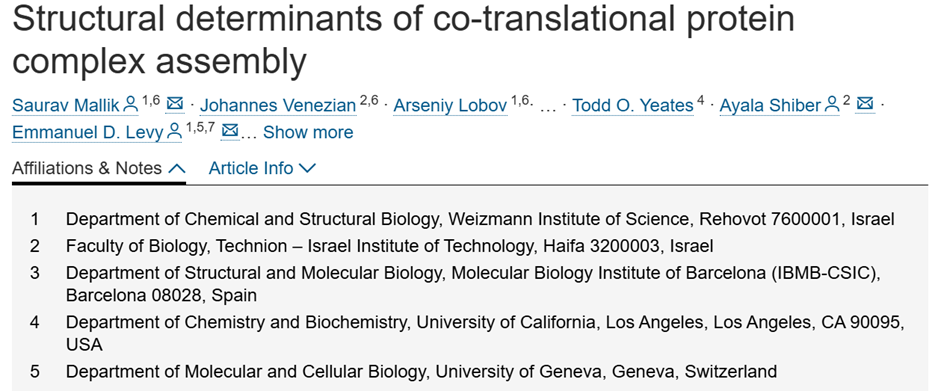
Protein assembly into functional complexes is critical to life’s processes. While complex assembly is classically described as occurring between fully synthesized proteins, recent work showed that co-translational assembly is prevalent in human cells. However, the biological basis for the existence of this process and the identity of protein pairs that assemble co-translationally remain unknown. We show that co-translational assembly is governed by structural characteristics of complexes and involves mutually stabilized subunits. Accordingly, co-translationally assembling subunits are unstable in isolation and exhibit synchronized proteostasis with their partner. By leveraging structural signatures and AlphaFold2-based predictions, we accurately predicted co-translational assembly, including pair identities, at proteome scale and across species. We validated our predictions by ribosome profiling, stoichiometry perturbations, and single-molecule RNA-fluorescence in situ hybridization (smFISH) experiments that revealed co-localized mRNAs. This work establishes a fundamental connection between protein structure and the translation process, highlighting the overarching impact of three-dimensional structure on gene expression, mRNA localization, and proteostasis.
蛋白质成功组装复合体对生命过程至关重要。传统观点认为复合体组装发生于完全合成的蛋白质之间,但近期研究表明共翻译组装在人类细胞中普遍存在。然而,这一过程存在的生物学基础以及参与共翻译组装的蛋白质对仍不明确。本研究发现共翻译组装受复合体结构特征调控,涉及相互稳定的亚基。因此,共翻译组装的亚基单独存在时不稳定,且与配对亚基呈现同步的蛋白稳态调控。通过结合结构特征和基于AlphaFold2的预测,研究者准确实现了跨物种、蛋白质组尺度的共翻译组装预测(包括配对鉴定)。研究者通过核糖体分析、化学计量扰动及显示mRNA共定位的单分子RNA荧光原位杂交(smFISH)实验验证了预测结果。这项研究揭示了蛋白质结构与翻译过程之间的本质联系,突显了三维结构对基因表达、mRNA定位和蛋白稳态的深远影响。
Synthetic organizer cells guide development via spatial and biochemical instructions
合成组织细胞通过空间与生化指令引导发育
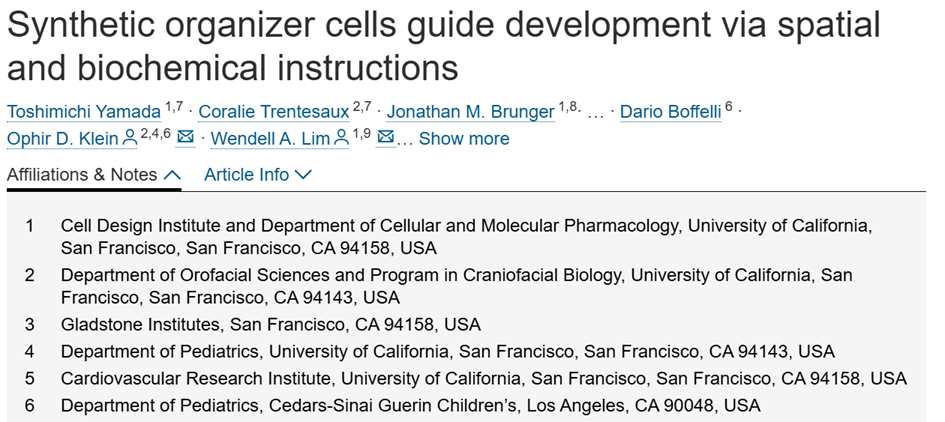
In vitro development relies primarily on treating progenitor cells with media-borne morphogens and thus lacks native-like spatial information. Here, we engineer morphogen-secreting organizer cells programmed to self-assemble, via cell adhesion, around mouse embryonic stem (ES) cells in defined architectures. By inducing the morphogen WNT3A and its antagonist DKK1 from organizer cells, we generated diverse morphogen gradients, varying in range and steepness. These gradients were strongly correlated with morphogenetic outcomes: the range of minimum-maximum WNT activity determined the resulting range of anterior-to-posterior (A-P) axis cell lineages. Strikingly, shallow WNT activity gradients, despite showing truncated A-P lineages, yielded higher-resolution tissue morphologies, such as a beating, chambered cardiac-like structure associated with an endothelial network. Thus, synthetic organizer cells, which integrate spatial, temporal, and biochemical information, provide a powerful way to systematically and flexibly direct the development of ES or other progenitor cells in different directions within the morphogenetic landscape.
体外发育主要依赖于使用培养基携带的形态发生素处理前体细胞,因而缺乏类原生的空间信息。本研究设计了一种可分泌形态发生素的组织细胞,这些细胞通过细胞粘附作用在特定结构中围绕小鼠胚胎干细胞(ES细胞)进行自组装。通过从组织细胞中诱导形态发生素WNT3A及其拮抗剂DKK1,研究者生成了具有不同作用范围和梯度陡度的多样化形态发生素分布。这些梯度与形态发生结果呈现强相关性:WNT活性最小值至最大值的作用范围决定了最终前-后(A-P)轴细胞谱系的分布范围。引人注目的是,虽然平缓的WNT活性梯度导致A-P谱系发育不全,却能产生更高分辨率的组织形态(如伴随内皮网络出现的节律性搏动、具有腔室结构的心脏样组织)。因此,这种整合空间、时间与生化信息的合成组织细胞,为在形态发生图谱中系统化、灵活地定向调控胚胎干细胞或其他前体细胞的多向发育提供了有力手段。
Spatiotemporal and genetic cell lineage tracing of endodermal organogenesis at single-cell resolution
单细胞分辨率下内胚层器官发生的时空与遗传谱系追踪
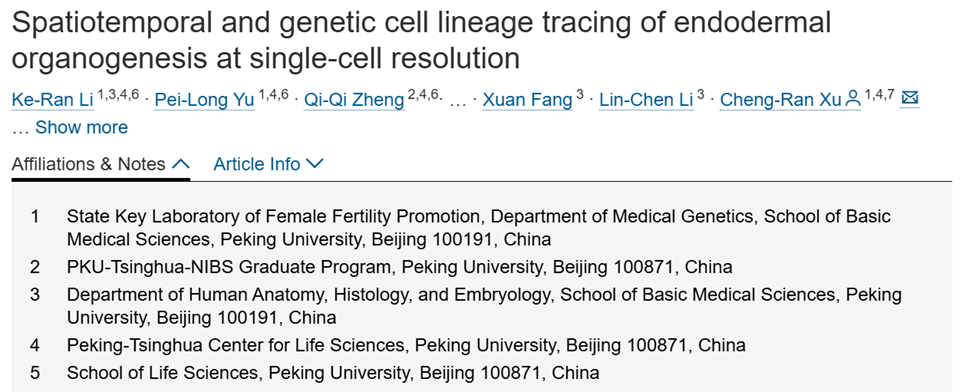
During early mammalian development, the endoderm germ layer forms the foundation of the respiratory and digestive systems through complex patterning. This intricate process, guided by a series of cell fate decisions, remains only partially understood. Our study introduces innovative genetic tracing codes for 14 distinct endodermal regions using novel mouse strains. By integrating high-throughput and high-precision single-cell RNA sequencing with sophisticated imaging, we detailed the spatiotemporal and genetic lineage differentiation of the endoderm at single-cell resolution. We discovered an unexpected multipotentiality within early endodermal regions, allowing differentiation into various organ primordia. This research illuminates the complex and underestimated phenomenon where endodermal organs develop from multiple origins, prompting a reevaluation of traditional differentiation models. Our findings advance understanding in developmental biology and have significant implications for regenerative medicine and the development of advanced organoid models, providing insights into the intricate mechanisms that guide organogenesis.
在哺乳动物发育早期,内胚层通过复杂的模式形成了呼吸系统和消化系统的基础。这一错综复杂的过程受到一系列细胞命运决定的引导,但目前人们对其仅有部分了解。本研究利用新型小鼠品系,为14个不同的内胚层区域引入了创新的遗传示踪编码。通过将高通量、高精度的单细胞RNA测序与先进的成像技术相结合,研究者以单细胞分辨率详细描绘了内胚层的时空分化和遗传谱系分化情况。研究者发现早期内胚层区域存在意想不到的多能性,这些区域能够分化为各种器官原基。这项研究揭示了内胚层器官自多个起源发育这一复杂且长期被低估的现象,促使人们重新评估传统的分化模型。研究者的研究结果推动了发育生物学领域的认知发展,对再生医学和高级类器官模型的开发具有重要意义,为指导器官发生的复杂机制提供了新见解。

汇报人:杨柠菲
导师:赵宇、任建君
审核:吴桂儀、任建君



